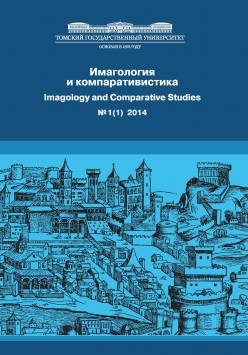On the genesis of the Neapolitan improvisator's image in A.S. Pushkin's Egyptian Nights. New materials
The numerous studies of the history of Egyptian Nights and the theme of Cleopatra in Pushkin's works hardly mention two possible sources of imagery and themes in Pushkin's short story: the translated articles "Egyptian Nights" and "Improvisatori". Both translations were published in Vestnik Evropy (The Herald of Europe) in 1802 and 1803 respectively. Their titles contain obvious imagery and lexical associations with the text by Pushkin. The wide European public got interested in Egypt and Egyptian themes in literature and journalism due to Napoleon's campaign that came amid collecting materials for the monumental work The Description of Egypt. The systematic study of Egyptian antiquities revived a forgotten culture. The cult of Egypt captivated Europe, and formal elements of Egyptian art left their mark on the style of the era, giving start to the Egyptian fashion. The Russian periodicals of the early 19th century focused on Egypt as well. Egypt became a cross-cutting theme in Vestnik Evropy that published articles and essays about Egyptian culture and modern political life. It was obvious that the passion for everything 'pseudo-Egyptian' was a well-spread tendency, too. It included mystical phenomena steeped in with mysteries and horrors of the ancient civilization. The article "Egyptian Nights" could influence the title of Pushkin's short story Egyptian Nights. Besides, it is worth mentioning the similarity of narrative structures between the journal essay and the prose passage of the third chapter in Pushkin's short story - in both texts it is the rout with improvised 'scary' stories the plots of which are based on erotic and thanatological motifs. The second essay, "Improvisatori", has a subhead "Translation from a French traveler, not yet published". It corresponds to the motif of travel in Egyptian Nights. "Improvisatori" in Vestnik Evropy is written in the form of a diary entries or essay: it is accompanied by the topographical indication "Naples", dated by April 7 and begins with the phrase: "Improvisators in Italy are poets who write poems and sing songs on any given subject". The way the poet looks in the journal publication resembles much that of the poet in Pushkin's short story. The reminiscences from the essay are obvious in some expressive details of Pushkin's Egyptian Nights: both texts contain a clear association of the improvisatore's image not just with Italy, but particularly with Naples and the same numbers and letter abbreviations appear in the journal publication and in the short story. However, despite some cross-cutting motifs and association of details, the image of the im-provisatore in Pushkin's short story bears such properties that have no analogues in any of the cited texts: the image of the improvisatore grows to the symbolic figure of the art discourse, artists and art. So, it is worth paying close attention to H.-C. Andersen's novel The Improvisatore (1833). The most striking parallel between Andresen's novel and Pushkin's short story is the psychological outline of the main character, with evident autobiographical motifs emphasized by the first person narrative. The hero of the novel, like that of Pushkin's short story, combines the talent of an improvisatore and a poet. The words 'poet' and 'improvisatore' in the course of the narrative are mainly used as synonyms. It should be noted that in the early editions of Egyptian Nights Pushkin also frequently used the words 'improvisatore' and 'poet' either as an apposition (poet-improvisator), or as synonyms. Like Pushkin, Andersen describes two appearances of the hero. Antonio sings his first improvisation to the accompaniment of guitars, like Pushkin's improvisatore. In both texts the improvisation is dedicated to sublime matters: immortality in Andersen's and vocation of the poet in Pushkin's. It should be noted that both texts contain a repeated motif of an associative analogy between the art of improvisation and the skill of the sculptor. In Egyptian Nights the motif of sculpturing is the main arguments in the discourse about the mysteries of creation. Although the cited fragments of Andersen's novel and Pushkin's short story are more than similar on the basis of their plot-forming motifs, it is still unknown whether this rapprochement contact or purely typological. If Pushkin was familiar with Andresen's novel, he could most likely do it via the Roman circle of artists and art lovers that gathered around Bertel Thorvaldsen in the 1830s. However, it is impossible to clarify this question within this article, thus it remains a promising issue for future research. Yet, the texts that are currently put into scientific circulation as potential sources of Pushkin's information about improvisa-tori and the art of improvisation traditionally attribute this branch of art to the nation of Italians as a whole. And the fact that Pushkin's hero is not just Italian, but particularly Neapolitan improvisatore draws attention to those texts of the Pushkin's epoch that demonstrate either associative or causal connection of improvisatori or the art of improvisation with the Neapolitan locus as to possible sources of imagery in Egyptian Nights.
Keywords
А.С. Пушкин, «Египетские ночи», источники образа импровизатора-неаполитанца, Г.-Х. Андерсен, роман «Импровизатор», компаративистика, A.S. Pushkin, Egyptian Nights, the sources of the Neapolitan improvisator's image, H.-C. Andersen, the novel Improvisator, comparative studiesAuthors
| Name | Organization | |
| Bohmig Michaela | L'Orientale University of Naples | mbohmig@unior.it |
References

On the genesis of the Neapolitan improvisator's image in A.S. Pushkin's Egyptian Nights. New materials | Imagologiya i komparativistika – Imagology and Comparative Studies. 2015. № 1 (3).